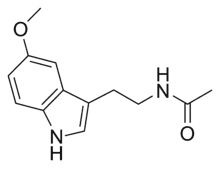All AbMole products are for research use only, cannot be used for human consumption.

Melatonin is a hormone made by the pineal gland that can activates melatonin receptor. Melatonin is a novel selective ATF-6 inhibitor and induces human hepatoma cell apoptosis through COX-2 downregulation. Melatonin plays a role in sleep and possesses important antioxidative and anti-inflammatory properties. Many biological effects of melatonin are produced through activation of melatonin receptors, while others are due to its role as a pervasive and powerful antioxidant, with a particular role in the protection of nuclear and mitochondrial DNA.
| Molecular Weight | 232.28 |
| Formula | C13H16N2O2 |
| CAS Number | 73-31-4 |
| Solubility (25°C) | DMSO 80 mg/mL Ethanol 10 mg/mL |
| Storage |
Powder -20°C 3 years ; 4°C 2 years In solvent -80°C 6 months ; -20°C 1 month |
[1] Sankha Bhattacharya, et al. Melatonin and its ubiquitous anticancer effects
[2] Susanna Esposito, et al. Pediatric sleep disturbances and treatment with melatonin
[3] Fernanda Gaspar do Amaral, et al. A brief review about melatonin, a pineal hormone
[4] B Claustrat, et al. Melatonin: Physiological effects in humans
[5] Armando L Morera-Fumero, et al. Role of melatonin in schizophrenia
| Related Melatonin Receptor Products |
|---|
| DH97
DH97 is a potent and selective antagonist of MT2 melatonin receptor, with a pKi of 8.03 for human MT2. |
| 8-M-PDOT
8-M-PDOT (AH-002) is a selective melatonin MT2 receptor agonist. |
| 6-Chloromelatonin
6-Chloromelatonin is a potent melatonin receptor agonist with greater metabolic stability than melatonin. |
| Melatonin-d4
Melatonin-d4 |
| Piromelatine
Piromelatine (Neu-P11) is a melatonin MT1/MT2 receptor agonist, serotonin 5-HT1A/5-HT1D agonist, and serotonin 5-HT2B antagonist. Piromelatine (Neu-P11) possesses sleep promoting, analgesic, anti-neurodegenerative, anxiolytic and antidepressant potentials. Piromelatine (Neu-P11) also possesses pain-related P2X3, TRPV1, and Nav1.7 channel-inhibition capacities. |
All AbMole products are for research use only, cannot be used for human consumption or veterinary use. We do not provide products or services to individuals. Please comply with the intended use and do not use AbMole products for any other purpose.


Products are for research use only. Not for human use. We do not sell to patients.
© Copyright 2010-2024 AbMole BioScience. All Rights Reserved.
